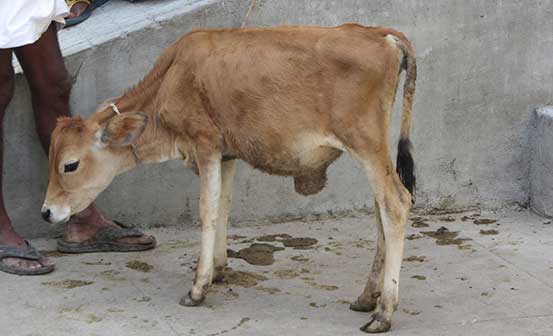
You may be familiar with hernia in human beings, especially children with protruding belly buttons; but this condition is also common in cattle, pigs and horses.
After the birth of a baby, the umbilical cord becomes useless because the baby starts feeding on its own. The cord thus wanes away, leaving a small stump whose opening closes. Hernia occurs when this opening fails to close.
Hernia is a medical term that refers to extrusion of thoracic, abdominal and pelvic organs through their protective wall and lodging just under the skin, causing an observable swelling. Herniation is an English word that describes the act of extrusion.
There are many types of hernia, but umbilical hernia is the commonest. Hernia can occur due to developmental anomalies or trauma that pushes organs located in the thoracic, abdominal or pelvic cavities.
Trauma can result from kicking and horn injuries during fights or in aggressive animals.
Hernias range in size from as small as a golf ball to as large as a football and are common in Friesians. Some hernias can be managed easily by gently pushing them back, while others cannot be pushed back. Sometimes, hernias can be infected and will require veterinary intervention.
Among the contents of hernias are intestines, liver, uterus, stomach, bladder or spleen, depending on its location. When this dislodging affects organ function the condition can be fatal.
I discuss three common types of hernias that livestock farmers are likely to encounter.
Umbilical Hernias
This hernia will occur around the umbilicus as a swelling. Umbilical hernia can be a congenital condition passed across family lines due to weakness in the umbilical ring.
It can also arise from disease conditions such as umbilical abscesses that subsequently cause loosening of surrounding muscles. In calves, umbilical hernias may result from improper handling at birth that results in manual breaking of the cord instead of letting it break off on its own.
They can also be caused by sudden and excess intra-abdominal pressure, for example, during birth, during stomach aches, defecation and urination coupled with weak umbilical ring muscles.
Umbilical hernias can take round, oval or spherical shapes. In most cases the lump will be cold and painless on touch. When pushed back or the animal lies on its back the content easily goes back.
Content of umbilical hernia can either be omentum (membranes and fats found between intestines) or intestines.
Stay informed. Subscribe to our newsletter
If the content is intestines you will be able to feel peristaltic movements and on percussion sharp sound will be heard. When the content is omentum the hernia will have a soft consistence and dull sound on percussion.
Sometimes umbilical hernias can be pathological and will be hot and painful when touched. In this case, the animal will develop a fever, lose appetite and suffer constipation.
This type of hernia is normally treated by open reduction, which involves a surgical operation.
In young animals, umbilical hernias are self-healing and surgical operations should be attempted after at least six months.
Adhesive plaster, belts around the abdomen and pressure bandages can be used to hasten the hernia reduction process.
Scrotal Hernia
This is commonly inherited and is characterised by an enlarged scrotal sac. You will observe the testicles lying side by side with a mass which can be either omentum or the intestines.
Due to many nerves around the scrotum the condition will be painful.
In young animals below one year the condition is self-healing but in older animals a surgical operation is needed.
Abdominal hernia
Abdominal hernias result from rupture of abdominal muscles.
They are common in cattle, pigs and horses and in most cases caused by traumatic injuries from kicks and horns or road accidents.
It is commonly observed in front or behind the umbilicus. The contents are normally large and small intestines, omentum, uterus, abomasum or urinary bladder.
The first sign of abdominal hernia is a swelling. In case you suspect your animal has any form of hernia, quickly call your animal health specialist.
(Dr Othieno is a veterinary surgeon working with the Kenya Tsetse and Trypanosomiasis Eradication Council - KENTTEC)
 The Standard Group Plc is a
multi-media organization with investments in media platforms spanning newspaper
print operations, television, radio broadcasting, digital and online services. The
Standard Group is recognized as a leading multi-media house in Kenya with a key
influence in matters of national and international interest.
The Standard Group Plc is a
multi-media organization with investments in media platforms spanning newspaper
print operations, television, radio broadcasting, digital and online services. The
Standard Group is recognized as a leading multi-media house in Kenya with a key
influence in matters of national and international interest.
 The Standard Group Plc is a
multi-media organization with investments in media platforms spanning newspaper
print operations, television, radio broadcasting, digital and online services. The
Standard Group is recognized as a leading multi-media house in Kenya with a key
influence in matters of national and international interest.
The Standard Group Plc is a
multi-media organization with investments in media platforms spanning newspaper
print operations, television, radio broadcasting, digital and online services. The
Standard Group is recognized as a leading multi-media house in Kenya with a key
influence in matters of national and international interest.


